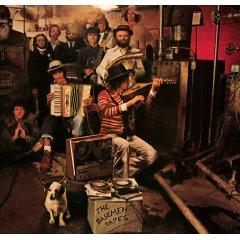
The Basement Tapes (1975)

Disc One
1. Odds and Ends
2. Orange Juice Blues (Blues for Breakfast)
3. Million Dollar Bash
4. Yazoo Street Scandal
5. Goin' to Acapulco
6. Katie's Been Gone
7. Lo and Behold!
8. Bessie Smith
9. Clothes Line Saga
10.Apple Suckling Tree
11.Please Mrs. Henry
12.Tears of Rage
Disc Two
1. Too Much of Nothing
2. Yea! Heavy and a Bottle of Bread
3. Ain't No More Cane
4. Crash on the Levee (Down in the Flood)
5. Ruben Remus
6. Tiny Montgomery
7. You Ain't Goin' Nowhere
8. Don't Ya Tell Henry
9. Nothing Was Delivered
10.Open the Door, Homer
11.Long Distance Operatior
12.The Wheel's on Fire
Few records better match their album cover than The Basement Tapes. From the very first glance, one senses the eccentric, rough-hewn atmosphere that awaits inside—a collage of musicians, misfits, and instruments in a state of jovial disorder. That visual perfectly anticipates the music within: spontaneous, raw, and gloriously unfiltered.
Recorded circa 1967 in the makeshift sanctuary of Big Pink, a house tucked away in the Woodstock countryside, these sessions marked a retreat from the escalating grandeur of Dylan's mid-sixties triumphs. Flanked by The Band—then recently evolved from their earlier incarnation as The Hawks—Dylan began laying down a collection of songs that would become legend well before their official release.
This is not a polished album. Nor is it meant to be. The performances have an endearing looseness, as if the group had simply plugged in on a rainy afternoon with no particular purpose other than to play. The arrangements are spare, the instrumentation homespun, and the atmosphere saturated with a kind of rustic surrealism. The songs, numbering 24 in this set, range from the absurd to the sublime, often within the same verse. Tracks like Million Dollar Bash and Clothes Line Saga abandon traditional narrative entirely, opting instead for lyrical playfulness and cryptic Americana wit.
Indeed, the nonsense is half the charm. Where Dylan’s early protest material leaned into societal observation, these songs veer into myth and folklore, or perhaps parodies thereof. When he does aim for narrative clarity, the results tend to stiffen slightly, but this minor flaw is easily forgiven in a collection that thrives on spontaneity.
The Band, for their part, are integral throughout—sometimes supporting, sometimes leading entirely. Their contributions are so symbiotic with Dylan’s own that the absence of his voice on several tracks does nothing to dilute the album’s cohesion. In fact, it amplifies its communal spirit, transforming it from a solo statement into a collective folk workshop.
The double-album format is not merely indulgent—it’s essential. Any tighter curation might have undercut the album’s central appeal: its meandering, exploratory nature. While not every track achieves transcendence, the whole is far greater than the sum of its parts. Subsequent releases of the full sessions decades later only confirmed the depth and breadth of this fertile period.
The Basement Tapes occupies a peculiar, almost mythic place in Dylan’s catalogue. It is not an album of hits, nor of immediate accessibility. But it remains a vital artifact of an artist—indeed, a group of artists—redefining what music could be when stripped of pressure, polish, and pretense. A rare portrait of pure creative freedom, it is, in its own ragged way, one of the essential Dylan recordings.
Go back to the main page
Go To Next Review